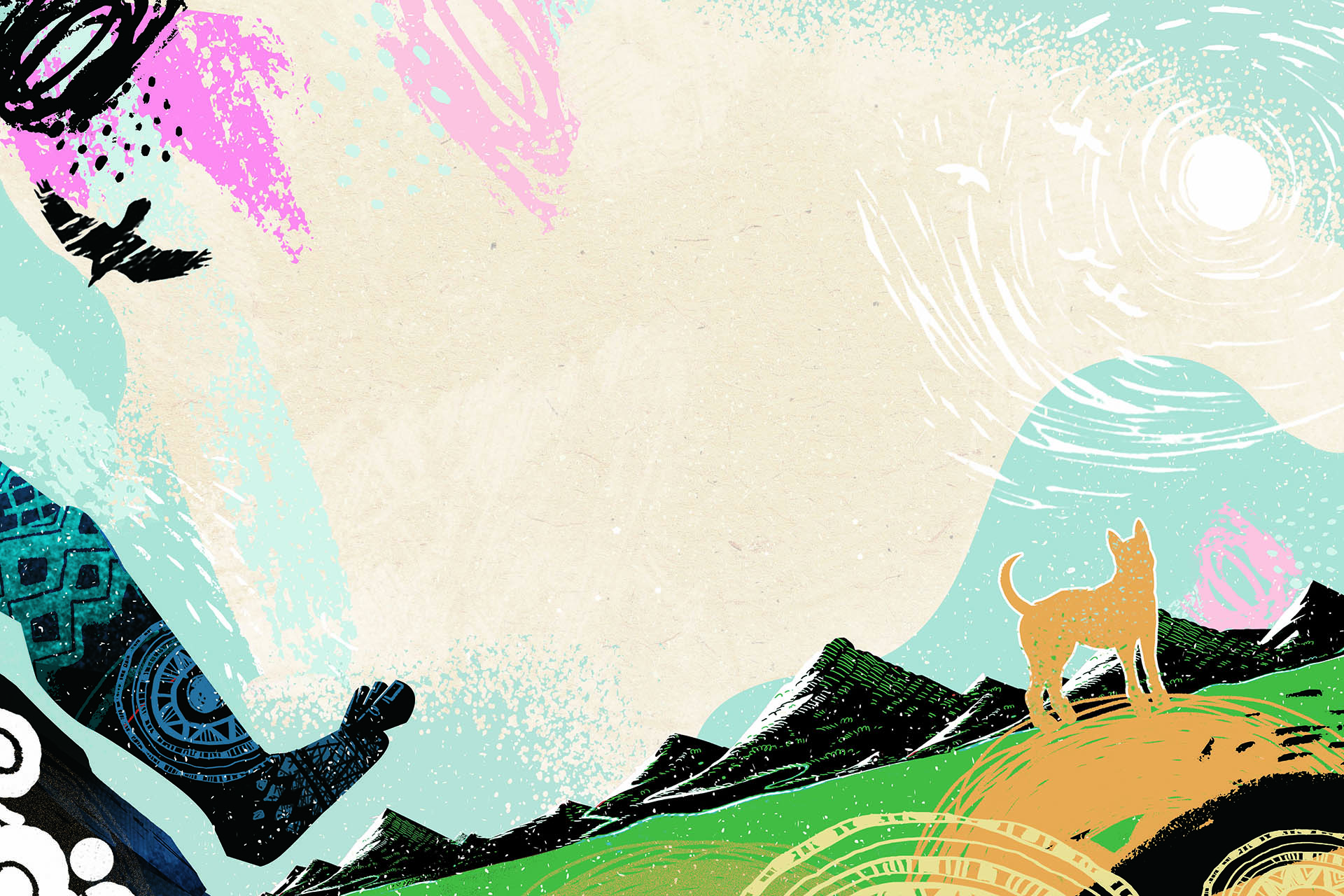Since the very beginning, the origins of human life have always been a great mystery to us.
Way before Darwin presented his Theory of Evolution which said that human evolved from primates, our ancestors were already thinking about this question. They used their limitless imagination and created many myths and legends, such as plants and animals gave birth to humans, God created Adam and Eve, etc. to explain where we came from.
In Taiwanese indigenous peoples myths, which were passed down via oral tradition, there are also a lot of interpretations on how life began and humans appeared on earth.
Once upon a time, there was a beautiful island, Taiwan, sitting quietly in the Pacific Ocean. It has a mild climate, lush mountains and wilderness, and abundant resources. Our ancestors were born on this precious island and lived in harmony with nature and all creatures. Creation myths from different indigenous peoples display a wide array of different interpretations and legends on how life started. There are versions that say humans were made by gods, and also extraordinary stories of how other creatures created humans. For example, there are stories that tell of how humans were born from stone, trees, eggs, or even feces. This shows the connections between our ancestors and nature and all its creatures, and how our ancestors understood the universe and the world.
The Amis origin of life story belongs to the “god created man” branch. Legend has it that the Great Amis sky god discovered Taiwan and thought it was a good place to live, so he sent a god and goddess to live in Taiwan. The two gods eventually fell in love and married, and their children were the ancestors of the Amis people.
We Actually
Came from Rocks!
In Atayal legends, they believe human beings came from rocks. Once upon a time, there was a huge rock on Nanhu Mountain (or, in some versions, Dabajian Mountain). The wise bird Siliq discovered the secret of the huge rock and prayed dutifully every day, hoping that the humans inside the rock would soon be born. Finally, on that fateful day, Siliq pushed the rock into the water where it split into two. A man and a woman walked out of the bright gold light and they became the ancestors of the Atayal people. The Atayal people interpret the calls made by Siliq, the hero that brought forth mankind, for divination purposes.
Even within the same group of people, their descendants may develop different versions of origin of life and place of origin stories since they live in different villages, areas, and environments. For example, there exists another origin of life story among the Atayal people, but both versions say that humans were born out of rocks. In this version, when the huge rock split open, there were two men and one woman, but one of the men was not used to the environment or thought Earth was too dangerous, so he immediately turned back into the warm embrace of the rock and refused to live and produce children in the world. The remaining couple stayed on the island to populate the land.
The Tao people also say humans were born from rocks. They believe children who come from rocks are the children of gods. Once upon a time, the thighs of a god suddenly began to swell, as if he had been stung by a mosquito. The swellings grew every day, until eventually a boy was born from his right knee, and a girl from the left. The god placed the boy in a rock, the girl in a bamboo section, and then left them on beautiful Orchid Island. The heavier rock landed on top of the mountain, and the lighter bamboo section was blown to the foot of the mountain. The rock boy and bamboo girl met on the island and gave birth to the ancestors of the Tao people.
We Are the Descendants
of Hundred-pacer Snakes!
The Paiwan people have a different view on how humans came into being. According to legends, a long time ago the sun god laid two eggs in a clay pot on top of Dawu Mountain. A hundred-pacer snake was left there to guard the eggs. Under the warm sun, a man and a woman hatched from the eggs. And they were the ancestors of the Paiwan people. Another version says that the god lowered a bamboo to the mortal world. When the bamboo hit the ground and split open, a lot of small snakes came out. These snakes grew and became humans, which are the ancestors of the Paiwan people. The Rukai people, who also have great respect towards the hundred-pacer snake, have similar legends as well. In the ancient times, a clay pot with two eggs in it floated over on the sea. Two hundred-pacer snakes hatched from the eggs and they were the ancestors of the Rukai people.
In the myths of the Paiwan and Rukai people, we see that both groups view clay pots as precious items, and have great respect towards hundred-pacer snakes. These all originated from the respect towards their ancestral spirits. Clay pots are the place of origin for their ancestors and the home of ancestral spirits; and the hundred-pacer snake is the embodiment of ancestral spirits and protectors of villages, thus should be highly respected and treated well, and should not be harmed or killed.
The Powerful Snake Spirit Fell in Love with Me:
The Introduction of Village Chiefs and Villages
As more people were born, the groups began to split into different villages. The introduction of respective villages, village chiefs, and aristocracy systems also inspired many interesting legends.
Once upon a time, Pjajuyajuyan, the chief of a Paiwan village, had three beautiful daughters. His eldest daughter, Moakaikai, was the most beautiful of the three sisters. One day, Pjajuyajuyan went into the forest to cut firewood. He found many pretty atap flowers near a tree, so he picked some for his daughters. Suddenly, a large snake appeared. The snake demanded that the father must give his most beautiful daughter to him as a bride, or he will bite and kill the father. To save her father, kind Moakaikai agreed to marry the snake. On the day of the wedding, the large snake and many of his friends, who had all transformed into handsome men, arrived with gifts. The large snake was in fact the sacred snake Kujijijiji, and he had only one purpose here in the mortal world - to make Moakaikai his wife. After hearing such a romantic declaration, Moakaikai followed Kujijijiji back to his home in the lake after the wedding and lived happily ever after. Their child also became a great village chief when he grew up.
In addition to the Paiwan people’s romantic love story, the Rukai people offer another view on how villages appeared. Legend has it that the goddess on Dawu Mountain fell in love with the lily flower, and impregnated the blossom through telepathy. The child became the ancestor of village chiefs. This is why the lily is considered as the spiritual symbol of the Rukai people. In another story, the villagers went on a hunt with a clouded leopard. When they reached the lake, the clouded leopard refused to budge. The Rukai people thought this was a sign from the gods, so they built a village here that spread out from the lake. This story is similar to the white deer story from the Thao people. These stories show that the expansion of different populations and appearances of new villages were closely linked to nature and its creatures.
Imagination
was the Superpower of Our Ancestors
Origin of Life stories from different indigenous peoples display the ancestors' rich imagination and wisdom. The emotional aspects in the stories also shape the cultural characteristics and original views of the universe and world of different peoples, joining together the hearts of community members.
These indigenous myths show people believed that mankind came from stone, trees, or eggs, and that all creatures in nature are linked together; and the shared stories prove that Taiwanese indigenous peoples treasure and respect the natural environment and its flora and fauna, and highlight that the cultural symbols worshipped by each group actually have an origin. These origin legends not only let us learn more about the land we live on and its history, but also indicate that at the very beginning of life, the distinction between nature and humans was not that definite as we thought.

- References -
小林保祥著,松澤員子編,謝荔譯,《排灣傳說集》,臺北市,南天書局,1998。
林道生編著,《原住民神話‧故事全集》(1~5),臺北市,漢藝色研,2001。
達西烏拉彎‧畢馬(田哲益),《魯凱族神話與傳說》,臺中市,晨星出版,2003。
達西烏拉彎‧畢馬(田哲益),《卑南族神話與傳說》,臺中市,晨星出版,2003。
達西烏拉彎‧畢馬(田哲益),《泰雅族神話與傳說》,臺中市,晨星出版,2003。
達西烏拉彎‧畢馬(田哲益),《阿美族神話與傳說》,臺中市,晨星出版,2003。
達西烏拉彎‧畢馬(田哲益),《排灣族神話與傳說》,臺中市,晨星出版,2003。
達西烏拉彎‧畢馬(田哲益),《布農族神話與傳說》,臺中市,晨星出版,2003。
達西烏拉彎‧畢馬(田哲益),《鄒族神話與傳說》,臺中市,晨星出版,2003。
夏曼藍波安,《八代灣的神話》,臺中市,晨星出版,1992。
巴蘇雅‧博伊哲努(浦忠成),《原住民的神話與文學》,臺北市,臺原出版,1999。胡台麗,《排灣文化的詮釋》,台北市,聯經,2011。






